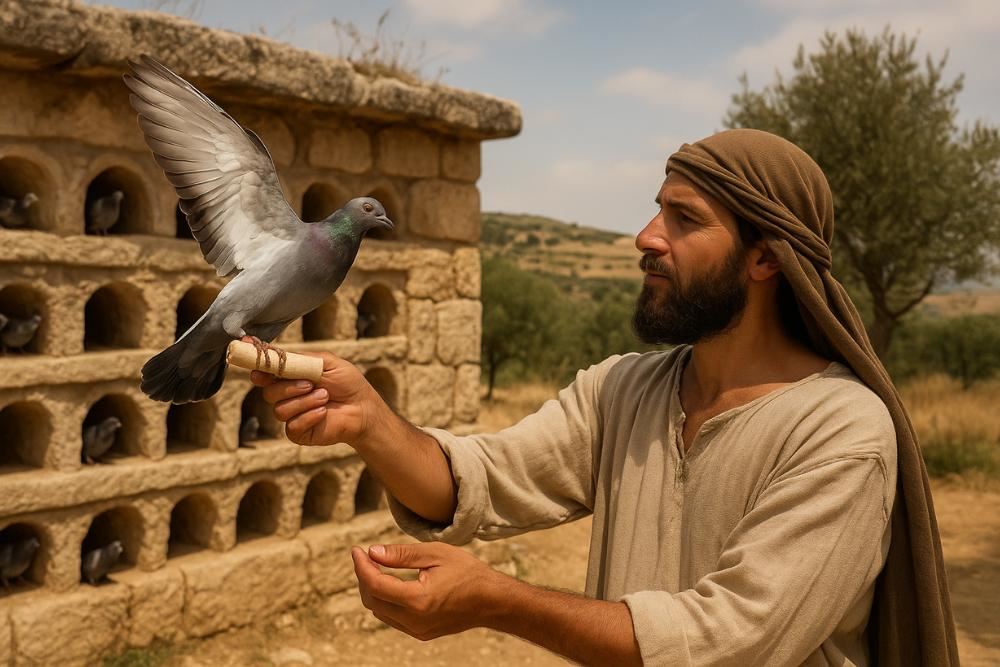Across history, few creatures carried messages as faithfully as the carrier pigeon. In the biblical world, the messenger pigeon was more than a practical helper—it was a symbol of peace, hope, and divine connection. From Noah’s dove with its olive branch to the pigeons raised in ancient dovecotes of Israel, these humble birds became both spiritual icons and vital tools of survival.
This article will explore how pigeons appear in the Hebrew Bible, their role in Jewish tradition and daily life, archaeological findings in ancient Israel, the lasting legacy of messenger pigeons in Jewish memory, and how this heritage is brought to life today at Kfar Kedem.
What is a Carrier Pigeon?
A carrier pigeon (or Homing Pigeon) is defined by its instinct to return home. Scientists believe this remarkable ability combines magnetic navigation, the use of the sun as a compass, and recognition of landmarks. This natural gift made pigeons the world’s most reliable ancient communication tool.

Carrier Pigeons in the Bible
The Hebrew Bible contains some of the earliest and most meaningful references:
Noah’s Dove (Genesis 8:8–12): Sent from the Ark to find dry land, the dove’s return with an olive branch became the universal image of peace and renewal.
Temple Sacrifices: Pigeons and doves were central in the sacrificial system, especially for families of modest means (Leviticus 1:14).
Prophecy and Poetry: Biblical writers used pigeons to symbolize innocence, reconciliation, and divine guidance (Isaiah 60:8, Psalm 55:6).
Together, these examples reveal how the messenger pigeon was woven deeply into the spiritual imagination of Israel.

Daily Life in Ancient Israel
Dovecotes and Household Use
Archaeological excavations in Israel reveal dovecotes at Marisha and Jericho, where pigeons were bred for food, fertilizer, and perhaps short signals or notes. Even ordinary families likely kept small pigeon lofts, with children helping to care for the birds. Their domestic presence explains why pigeons appear so often in psalms and stories.
Pigeons and Agriculture
Pigeon droppings were highly valued as fertilizer, sustaining fields and vineyards. This agricultural importance deepened biblical imagery, linking pigeons not only to peace but also to prosperity and provision.

How Carrier Pigeons Worked in the Biblical World?
The principle is simple: pigeons always return to their home loft. Ancient Israelites may have used this instinct for communication through pigeons across short distances.
Mechanics of a Pigeon Note
A piece of parchment, papyrus, or leather—rolled tightly—was tied to the leg or placed in a reed container. Pigeons could cover many kilometers quickly, making them ideal for urgent, short messages. The system was mostly one-way; two-way communication required pigeons at both ends.
A simple pigeon note could carry news of danger, harvest, or community needs. While not described directly in the Bible, this practice fits the realities of ancient Israel.
Training and Trust
Young pigeons were trained gradually, beginning with short flights and extending to longer ones. Over time, pigeons became trusted companions in crises. Beyond the practical, they carried symbolic meaning that shaped Jewish tradition.
The Living Experience of Biblical Communication
Picture this: your fingers cradle a messenger pigeon as you tie a small scroll to its leg. The cooing of birds fills the dovecote, blending with Galilean winds through olive trees. As you release the pigeon, wings flutter and silence falls. Waiting begins—the same anticipation felt by countless generations.
The most magical moment comes when the pigeon returns, a silhouette against the Galilean sky. Its safe arrival echoes the cycle of sending and receiving that sustained communities and carried prayers across Jewish history.
Symbolism and Jewish Tradition
Pigeons embodied values beyond practicality:
- Peace: Noah’s dove became an eternal emblem of hope.
- Provision: Offered in the Temple, pigeons reflected God’s accessibility to all.
- Faithfulness: Their homing instinct symbolized Israel’s covenant with God.
Rabbinic Lessons
Later rabbinic sources expanded these ideas. Pigeons were seen as symbols of loyalty and fidelity, teaching moral lessons about repentance and return. Just as pigeons never forget their loft, Israel was called to never forget its bond with the divine.
Sacred Stories and Living Tradition
Talmudic sources record pigeons used for urgent halakhic questions. The Midrash describes “calendar pigeons” announcing the new moon. One rabbinic tale tells of a pigeon delivering a ruling just in time for Shabbat observance. Isaiah’s vision of doves streaming home (Isaiah 60:8) became a divine promise, and the Zohar compares Jewish prayers to pigeons returning to their lofts—always reaching God.
These stories show how communication through pigeons became sacred, every flight echoing faith and covenant.
Archaeological Findings in Israel
Findings confirm pigeons’ importance:
- Dovecotes: Large and small structures highlight their central role.
- Bones and Remains: Abundant finds confirm dietary and economic use.
- Cultic Contexts: Some remains suggest ritual use, aligning with biblical accounts.
This evidence shows pigeons were both symbolic and practical.

From the Bible to Jewish Memory
Though organized pigeon posts came later, the roots of carrier pigeon history lie in biblical Israel. The Hebrew Bible gave pigeons their symbolic meaning, while rabbinic tradition preserved their role as faithful messengers of peace and covenant.
Experience Carrier Pigeons at Kfar Kedem
At Kfar Kedem, visitors step into this heritage. Our Carrier Pigeon activity invites you to release pigeons along Galilee’s ancient trails, watch them return to their lofts, and experience firsthand how carrier pigeons work. Sending a pigeon note ties you directly to Jewish memory and biblical practice.

Carrying Forward Ancient Wisdom
When you leave Kfar Kedem after releasing a pigeon, you carry more than a memory. You carry lessons in patience, faith, and trust. The pigeon that returns to its loft embodies eternal truths: no matter how far we journey, we never forget the way home. In today’s age of instant messages, the carrier pigeon reminds us that meaningful communication often takes time, intention, and trust.
Messengers of Faith and Peace
From Noah’s Ark to the Temple courts, pigeons carried messages both symbolic and real. They were sacrifices, symbols of divine promise, and daily companions. Their story is part of communication history and inseparable from Jewish identity.
Today, at Kfar Kedem, you can rediscover this heritage for yourself. The humble messenger pigeon continues to remind us that even the smallest creatures can carry the greatest truths—faith, hope, and the enduring covenant between God and Israel.